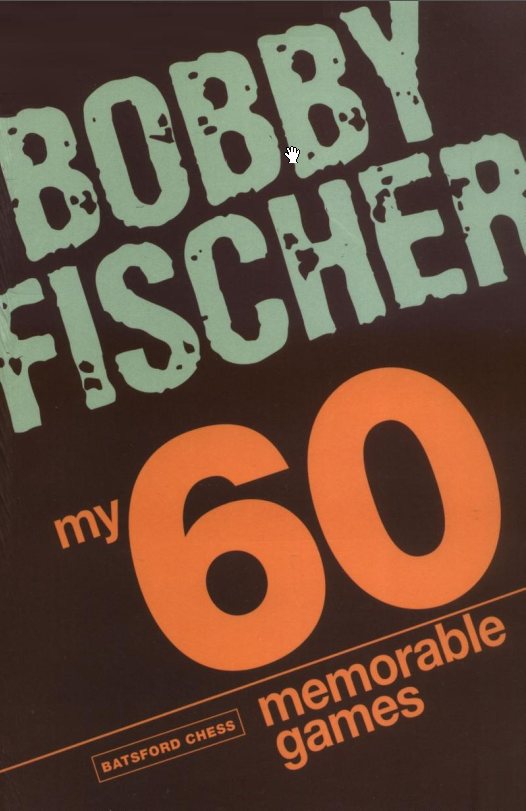
📘 Book Overview
- Title: My 60 Memorable Games
- Author: Bobby Fischer
- First Published: 1969
- Purpose: Fischer’s personal selection of his greatest games up to that point, annotated with his own analysis, commentary, and reflections. It’s not just a games collection—it’s Fischer’s chess autobiography in analytical form.
♟️ Content Breakdown & Key Themes
- Structure: 60 annotated games, spanning 1957–1967, against world-class opponents like Tal, Petrosian, Keres, Botvinnik, and Spassky.
- Annotations: Fischer combines detailed analysis with candid comments (“A bust!”; “I was lucky.”).
- Themes Explored:
- The evolution of his opening repertoire (Sicilian Najdorf, King’s Indian, Grünfeld, Ruy Lopez).
- Practical struggles and psychological battles.
- Precision in calculation and relentless pursuit of advantage.
- Illustrative Games:
- Game 17 vs. Donald Byrne (“The Game of the Century” – though not annotated here, its echoes remain).
- Game 6 vs. Byrne (1963) – a model King’s Indian Attack.
- Game 37 vs. Petrosian – an incisive Grünfeld demolition.
- Game 45 vs. Spassky – foreshadowing their 1972 World Championship clash.
🧠 Depth, Accuracy & Teaching Style
- Fischer’s analysis was astonishingly accurate for a pre-computer era—many of his evaluations stand up even today.
- His teaching style is blunt, direct, and practical—no flowery language, just clarity.
- Not a beginner’s book: the variations are deep and require effort, but they teach calculation and critical thinking at the board.
📊 Strengths & Weaknesses
✅ Strengths:
- Immortal games with Fischer’s own voice—unique insight.
- Combination of concrete variations and pithy psychological commentary.
- Still highly relevant for opening ideas and middlegame strategies.
- A rare balance of literature and instruction—Fischer wrote as a fighter, not a lecturer.
❌ Weaknesses:
- Not for casual players: variations are sometimes dense and demand strong tactical skills.
- Sparse verbal explanations compared to modern instructional books.
- No structured lessons—learning is indirect, through immersion in Fischer’s thought process.
👥 Target Audience
- Intermediate (1500+) and above: Those comfortable with notation and eager to dive into complex middlegame and opening analysis.
- Advanced (2000+): A goldmine—serious study material with ideas still applicable in master-level play.
🏆 Historical & Practical Significance
- Considered one of the greatest chess books ever written—often ranked alongside Nimzowitsch’s My System and Bronstein’s Zurich 1953.
- Set a new standard for annotated games collections.
- Captures Fischer at his peak ascent, just before becoming World Champion.
📌 Key Takeaways & Lessons
- Fight for the initiative – Fischer shows time and again that activity and energy outweigh material.
- Opening preparation pays off – his deep Sicilian and King’s Indian work created lasting models.
- Clarity over complexity – Fischer sought logical, forcing continuations, not murky complications.
- Relentlessness – Fischer pressed advantages until his opponent cracked, never letting go.
- Psychological edge – his annotations reveal how confidence and mindset shaped decisions.
- Calculation discipline – working through Fischer’s lines trains raw calculation ability.
- Transition to endings – many games highlight smooth conversion from middlegame initiative to endgame victory.
- Directness of style – Fischer stripped chess of artifice, aiming always for “the truth.”
📚 Study Plan
Beginner (0–1200):
- Skim through for inspiration and famous games.
- Play through complete games quickly to absorb patterns.
- Focus on Fischer’s attacking ideas (Games 6, 17, 20).
Intermediate (1200–1800):
- Study 1–2 games per week, replaying without notes first.
- After guessing moves, compare with Fischer’s analysis.
- Pick openings Fischer played (Najdorf, King’s Indian Attack) and practice them online.
Advanced (1800+):
- Deeply annotate selected games yourself before reading Fischer’s notes.
- Cross-check Fischer’s analysis with modern engines—see where he was ahead of his time.
- Thematically group games (e.g., his Najdorf games, his Grünfeld battles).
- Recreate positions over the board and calculate without moving pieces.
🔗 Recommended Next Steps
- Bronstein’s Zurich 1953 – for tournament game annotations.
- Kasparov’s My Great Predecessors I – includes Fischer’s games in broader context.
- Dvoretsky’s Analytical Manual – to sharpen calculation skills Fischer-style.
✅ Final Verdict
- Clarity: ★★★★☆
- Depth: ★★★★★
- Usefulness: ★★★★☆
- Overall Value: ★★★★★
Summary: My 60 Memorable Games is not just a chess book—it’s an intimate conversation with Fischer at his peak. It demands effort, but rewards the serious student with timeless lessons in calculation, initiative, and uncompromising chess. It belongs on every ambitious player’s shelf.





cmfx5l
**mind vault**
mind vault is a premium cognitive support formula created for adults 45+. It’s thoughtfully designed to help maintain clear thinking
**mind vault**
mind vault is a premium cognitive support formula created for adults 45+. It’s thoughtfully designed to help maintain clear thinking
**sugarmute**
sugarmute is a science-guided nutritional supplement created to help maintain balanced blood sugar while supporting steady energy and mental clarity.
**glpro**
glpro is a natural dietary supplement designed to promote balanced blood sugar levels and curb sugar cravings.
**prostadine**
prostadine is a next-generation prostate support formula designed to help maintain, restore, and enhance optimal male prostate performance.
**prodentim**
prodentim an advanced probiotic formulation designed to support exceptional oral hygiene while fortifying teeth and gums.
**vitta burn**
vitta burn is a liquid dietary supplement formulated to support healthy weight reduction by increasing metabolic rate, reducing hunger, and promoting fat loss.
**glucore**
glucore is a nutritional supplement that is given to patients daily to assist in maintaining healthy blood sugar and metabolic rates.
**nitric boost**
nitric boost is a dietary formula crafted to enhance vitality and promote overall well-being.
**synaptigen**
synaptigen is a next-generation brain support supplement that blends natural nootropics, adaptogens
**mitolyn**
mitolyn a nature-inspired supplement crafted to elevate metabolic activity and support sustainable weight management.
**zencortex**
zencortex contains only the natural ingredients that are effective in supporting incredible hearing naturally.
**wildgut**
wildgutis a precision-crafted nutritional blend designed to nurture your dog’s digestive tract.
**yu sleep**
yusleep is a gentle, nano-enhanced nightly blend designed to help you drift off quickly, stay asleep longer, and wake feeling clear.
**breathe**
breathe is a plant-powered tincture crafted to promote lung performance and enhance your breathing quality.
**pinealxt**
pinealxt is a revolutionary supplement that promotes proper pineal gland function and energy levels to support healthy body function.
**energeia**
energeia is the first and only recipe that targets the root cause of stubborn belly fat and Deadly visceral fat.
**boostaro**
boostaro is a specially crafted dietary supplement for men who want to elevate their overall health and vitality.
**prostabliss**
prostabliss is a carefully developed dietary formula aimed at nurturing prostate vitality and improving urinary comfort.
**potent stream**
potent stream is engineered to promote prostate well-being by counteracting the residue that can build up from hard-water minerals within the urinary tract.
**hepatoburn**
hepatoburn is a premium nutritional formula designed to enhance liver function, boost metabolism, and support natural fat breakdown.
**hepatoburn**
hepatoburn is a potent, plant-based formula created to promote optimal liver performance and naturally stimulate fat-burning mechanisms.
**flow force max**
flow force max delivers a forward-thinking, plant-focused way to support prostate health—while also helping maintain everyday energy, libido, and overall vitality.
**prodentim**
prodentim is a forward-thinking oral wellness blend crafted to nurture and maintain a balanced mouth microbiome.
**cellufend**
cellufend is a natural supplement developed to support balanced blood sugar levels through a blend of botanical extracts and essential nutrients.
**revitag**
revitag is a daily skin-support formula created to promote a healthy complexion and visibly diminish the appearance of skin tags.
**neurogenica**
neurogenica is a dietary supplement formulated to support nerve health and ease discomfort associated with neuropathy.
**sleeplean**
sleeplean is a US-trusted, naturally focused nighttime support formula that helps your body burn fat while you rest.
I always was concerned in this topic and stock still am, appreciate it for putting up.
Had a flutter on 33win39bet. Managed to win a little something back, so can’t complain! Worth a try if you fancy your chances. Good luck to everyone!33win39bet
of course like your website however you need to take a look at the spelling on several of your posts. Many of them are rife with spelling issues and I find it very bothersome to tell the reality however I’ll certainly come back again.
I’ve been browsing online more than three hours today, yet I never found any interesting article like yours. It’s pretty worth enough for me. Personally, if all site owners and bloggers made good content as you did, the web will be a lot more useful than ever before.
Không chỉ sở hữu chứng nhận hợp pháp bởi CURACAO Gaming, slot365 casino còn được đánh giá cao khi toàn bộ trang web đều vận hành đảm bảo theo tiêu chuẩn mã hóa SSL 12 Bit. Chúng tôi nói không tuyệt đối với những hành vi xâm nhập từ bên thứ ba không rõ nguồn gốc.
1PHBetLogin makes it easy to get in and play. No complicated stuff. If you want simple, check it 1phbetlogin.